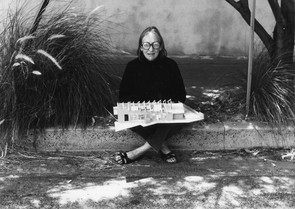Hidden in the Catalina Foothills is a $2.5 million home surrounded by nearly nine acres of land. Although this is one of the largest parcels of land in the foothills and a pricey piece of real estate for the Tucson market, the immensity and price are not the most impressive parts of this home.
Built in 1975, the “Ramada House” designed by Judith Chafee earned its name from the extensive wooden ramada providing temperature control and shade to the entire home. The Ramada House, along with other artifacts from the life and work of Chafee, will be featured at Special Collections in the University of Arizona Main Libraries this January through July, with its debut event on Jan. 22.
“She didn’t get the kind of recognition she deserved,” said Bob Diaz, an associate librarian who worked to put this exhibit together. “She was a genius as far as I’m concerned.”
One of Diaz’s goals with this exhibit is to showcase how Chafee evolved as an artist while also incorporating her personal life and time in Tucson.
“I wanted to bring out her art because I don’t think people realize how an artist can expand and grow and change and move in different directions,” Diaz said. “But she certainly found her niche; architecture was her life.”
RELATED: Southwest Exhibition at the El Conquistador Tucson Launches This February
After growing up in Tucson, Chafee moved to Connecticut to study at Yale University and begin her career.
“She started with painting and art and furniture designs,” Diaz said. “She designed a chair that she patented, so she owns a patent on a really cool swivel chair. She moved into both interior design and architecture, but after she was known as an architect because of the stunning treasures that she created.”
Chafee moved back to Tucson in 1970 and built a variety of private homes, always with the specific needs of her clients and the desert in mind.
“She built some incredible buildings that were in tune with the environment. She used a lot of solar energy when that wasn’t as popular as it is now,” Diaz said. “Having grown up in Tucson, she was very aware of the importance of having shade and things like that, but she also was very attentive to the needs of the clients. She had very few public buildings but some incredible private homes that she built.”
Diaz describes Chafee as not only being a strong architect, but also having a strong and vibrant personality.
“She had a conscious, active stance on the environment and a liberal attitude toward things,” Diaz said. “She was not conservative; she drank and she smoked and she cussed.”
Chafee also maintained her own high standards and opinions on beauty and excellence that caused her to clash with others. One of her most notable buildings, Blackwell, is remembered more for the controversy than the architecture.
“Blackwell wasn’t so much a gem as it was controversial, and probably the best-known house because of the controversy,” Diaz said. “It was in the Tucson mountains and there was a fight between different county administrators and the bulldozers showed up one day and it was gone.”
UA Libraries began acquiring Chafee and other architecture work in the 1980s, but the work was transferred between institutions before returning to the university in 2011.
“The college of architecture had a big collection they started it in the ’80s. It was called the Arizona Architectural Archives, but with budget cuts and all, the collections got transferred here and there and ended up with us in 2011,” Diaz explained. “Since then, we’ve been steadily working on getting it organized and making it available to the public.”
After organizing her work for seven years, the department of architecture and UA Libraries are excited to share Chafee’s art with the public.
RELATED: Hanson Film Institute and UAMA bring art to the screen
“This is the bringing out of the collection we acquired in 2011. It has taken this long, but at least we’re there,” Diaz said. “This is going to be huge. The community just loves architecture, and there’s a huge interest in her in particular.”
The exhibit debut has already received over 150 RVSPs and is expecting an enthusiastic turnout. Chafee’s work will be on display in the Special Collections hall next to the UA main library until June, and is free and open to the public.









